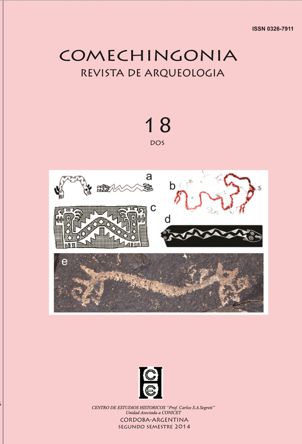El estudio arqueológico del proceso de intensificación. Casos de Europa y América del Sur.
Contenido principal del artículo
Resumen
Downloads
Detalles del artículo
Sección
COPYLEFT
Este obra está bajo una licencia de Creative Commons Reconocimiento-Compartir Igual 4.0 Internacional.
COPYRIGTH
Los derechos de autor y de copyright de los artículos son de los mismos autores.
Esto estará indicado en cada artículo, asi como la licencia Copyleft anteriormente descrita.
Cómo citar
Referencias
Berón, M.A. 2005 Circulación de bienes como indicador de interacción entre las poblaciones de la pampa occidental y sus vecinos. Comunicación al 4to. Congreso de Arqueología de la Región Pampeana Argentina, Bahía Blanca.
Binford, L. 2001 Constructing Frames of Reference: An Analytical Method for Archaeological Theory Building Using Ethnographic and Environmental Data Sets. University of California Press, Berkeley.
13El estudio arqueológico de los procesos de intensificación..
Bright, J., A. Ugan, y L. Hunsaker 2002 The Effect of Handling Time on Subsistence Technology. World Archaeology 34:164–181.
Brookfield, H.C. 1972 Intensification and disintensification in Pacific agriculture: a theoretical approach. Pacific Viewpoint 13: 211-238.
Broughton, J.M. 1999 Resource Depression and Intensification during the Late Holocene, San Francisco Bay: Evidence from Emeryville Shellmound Vertebrate Fauna. University of California Press, Berkeley.
Broughton, J.; M. Cannon y E. Bartelink 2010 Evolutionary Ecology, Resource Depression, and Niche Construction Theory: Application to Central California hunter-gatheres and Mimbres-Mogollon agriculturalist. Journal of Archaeological Method and Theory 17:371-421
Broughton, J. M. y J. F. O’Connell 1999 On evolutionary ecology, selectionist archaeology and behavioral archaeology. American Antiquity 64: 153–165.
Cohen, M. N. 2009 Introduction: rethinking the origins of agriculture. Current Anthropology 50: 591–595.
Farrington, I.S. 1985 The wet, the dry, and the steep: Archaeological imperatives and the study of agricultural intensification. Prehistoric Intensive Agriculture in the Tropics (ed. porI. S. Farrington), Vol. 1, pp. 1–9. British Archaeological Reports International Series 232.
González, M.I. 2005 Arqueología de alfareros, cazadores y pescadores pampeanos. Sociedad Argentina de Antropología, Buenos Aires.
Grayson, D. K. y F. Delpech 1998 Changing Diet Breadth in the Early Upper Paleolithic of Southwestern France. Journal of Archaeological Science 25: 1119-1129.Holdaway, S., P. Fanning y E. Rhodes 2008 Challenging intensification: human-environment interactions in the Holocene geoarchaeological record from western New South Wales, Australia. The Holocene 18(3): 403-412.
Janetsky, J. 1997 Fremont hunting and resource intensification in the eastern Great Basin. Journal of Archaeological Science 24, 1075-1088.
Kirsch, P.V. 2005 Archaeology and global change: the Holocene record. Annual Review of Environmental Resources 30: 409-440.
Leach, H. 1999 Intensification in the Pacific: a critique of the archaeological criteria and their application. Current Anthropology 40 (3): 311-339.
14 Comechingonia 18 (segundo semestre de 2014) ISSN:0326-7911- M. Medina y L. Prates Pp.:9-15
López Mazz, José M. 2001 Las estructuras tumulares (cerritos) del Litoral Atlántico uruguayo. Latin American Antiquity 12: 1–25.
Lourados, H. 1997 Continent of hunter-gatherers. New perspectives in Australian prehistory. Cambridge University Press.
Lourados, H. y A. Ross 1999 The great ‘intensification debate’: its history and place in Australian archaeology. Australian Archaeology 39: 54-63.
Martínez, G. 1999 Tecnología, Subsistencia y Asentamiento en el Curso Medio del Río Quequén Grande: Un Enfoque Arqueológico. Tesis doctoral no publicada. Facultad de Ciencias Naturales y Museo, Universidad Nacional de La Plata.
Mazzanti, D.L. 2006 La constitución de territorios sociales durante el Holoceno tardío. El caso de las sierras de Tandilia, Argentina. Relaciones de la Sociedad Argentina de Antropología 31: 277-300.
Miotti, L.L. 2012 El uso de los recursos faunísticos entre los cazadores-recolectores de Patagonia: tendencias espacio/temporales de las estrategias durante el Holoceno. Archaeofauna 21: 137-160.
Morrinson, K. 1994 The Intensification of Production: Archaeological Approaches. Journal of Archaeological Method and Theory 1(2): 111-159.
Nagaoka, L. 2002 The effects of resource depression on foraging efficiency, diet breadth, and patch use in southern New Zealand. Journal of Anthropological Archaeology 21: 419-442.
Neme, G. 2007 Cazadores-Recolectores de Altura en los Andes Meridionales: El Alto Valle del Río Atuel. British Archaeological Series 1591, Archaeopress, Oxford.
Odling-Smee, J.; k. Laland and M. Feldman 2003 Niche Construction. The Neglected Process in Evolution. Princeton University Press, Princeton.
Prates, L. 2008 Los Indígenas del Rio Negro. Un Enfoque Arqueológico. Sociedad Argentina de Antropología, Buenos Aires. Quintana, C. A., F. Valverde y D. L. Mazzanti 2002 Roedores y lagartos como emergentes de la diversificación de la subsistencia durante el Holoceno tardío en las sierras de la región pampeana. Latin American Antiquity 13 (4): 455-473.
15El estudio arqueológico de los procesos de intensificación..
Stiner, M.C., N. Munro; T. Surovell; E. Tchernov y O. Bar-Yosef 1999. Paleolithic population growth pulses evidenced by small animal exploitation. Science 283: 190–194.
Stoessel L. 2012 Evaluating Intensity in the Processing of Guanaco (Lama Guanicoe) at the Lower Basin of the Colorado River (Argentina): Fragmentation Levels and Fracture Patterns Analysis. International Journal of Osteoarchaeology 24, 51-67.
Thakar, H.B. 2011 Intensification of shellfish exploitation: evidence of species-specific deviation from traditional expectations. Journal of Archaeological Science 38 (2011) 2596-2605.
Tringham, R. E., and D. Krstic 1990. Conclusion: Selevac in the wider context of European prehistory. Selevac: A Neolithic Village in Yugoslavia (ed.por R.Tringham y D. Krstic), pp. 567-616. UCLA Institute of Archaeology, Los Angeles.
Yacobaccio, H.D. 2006. Intensificación económica y complejidad social en cazadores-recolectores surandinos. Boletín de Arqueología PUCP 10: 305-320.
Winterhalder, B. y D.J. Kennett 2006 Behavioral Ecology and the Transition from Hunting and Gathering to Agriculture. Behavioral Ecology and the Transition to Agriculture (ed. por D.J. Kennett y B. Winterhalder), pp. 1-21. University of California Press. Berkeley.
Zangrando, A.F.J. 2009. Is fishing intensification a direct route to hunter-gatherer complexity? A case study from the Beagle Channel region (Tierra del Fuego, southern South America). World Archaeology 41(4): 589–608.




